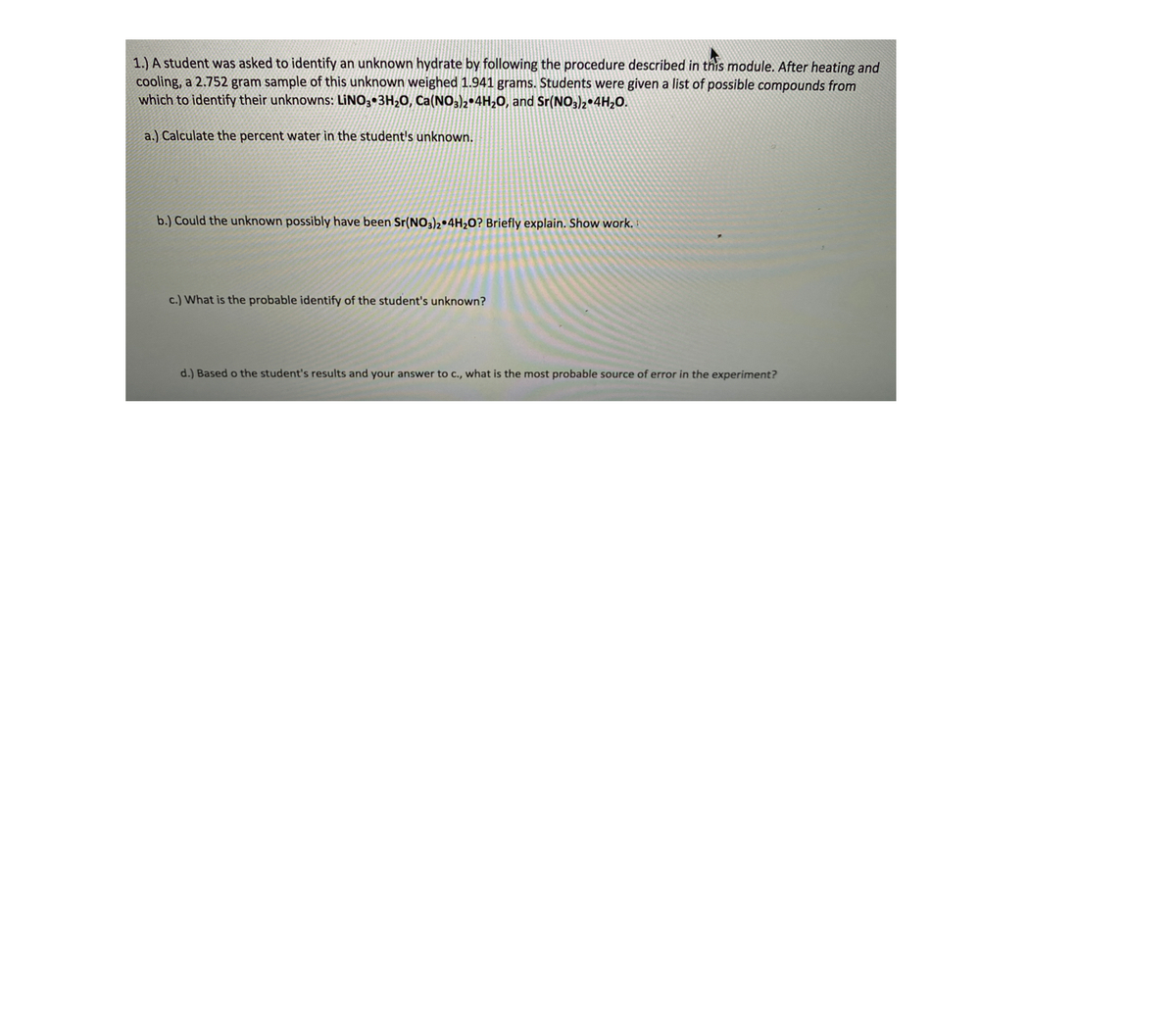1.) A student was asked to identify an unknown hydrate by following the procedure described in this module. After heating and cooling, a 2.752 gram sample of this unknown weighed 1.941 grams. Students were given a list of possible compounds from which to identify their unknowns: LINO3 3H20, Ca(NO,)2•4H20, and Sr(NO3)2•4H20. a.) Calculate the percent water in the student's unknown. b.) Could the unknown possibly have been Sr(NO)2•4H,0? Briefly explain. Show work. c.) What is the probable identify of the student's unknown? d.) Based o the student's results and your answer to c., what is the most probable source of error in the experiment?
1.) A student was asked to identify an unknown hydrate by following the procedure described in this module. After heating and cooling, a 2.752 gram sample of this unknown weighed 1.941 grams. Students were given a list of possible compounds from which to identify their unknowns: LINO3 3H20, Ca(NO,)2•4H20, and Sr(NO3)2•4H20. a.) Calculate the percent water in the student's unknown. b.) Could the unknown possibly have been Sr(NO)2•4H,0? Briefly explain. Show work. c.) What is the probable identify of the student's unknown? d.) Based o the student's results and your answer to c., what is the most probable source of error in the experiment?
Chemistry: The Molecular Science
5th Edition
ISBN:9781285199047
Author:John W. Moore, Conrad L. Stanitski
Publisher:John W. Moore, Conrad L. Stanitski
Chapter13: The Chemistry Of Solutes And Solutions
Section13.7: Colligative Properties Of Solutions
Problem 13.16E: Suppose that you are closing a cabin in the north woods for the winter and you do not want the water...
Related questions
Question
Question attached

Transcribed Image Text:1.) A student was asked to identify an unknown hydrate by following the procedure described in this module. After heating and
cooling, a 2.752 gram sample of this unknown weighed 1.941 grams. Students were given a list of possible compounds from
which to identify their unknowns: LINO3 3H20, Ca(NO,)2•4H20, and Sr(NO3)2•4H20.
a.) Calculate the percent water in the student's unknown.
b.) Could the unknown possibly have been Sr(NO)2•4H,0? Briefly explain. Show work.
c.) What is the probable identify of the student's unknown?
d.) Based o the student's results and your answer to c., what is the most probable source of error in the experiment?
Expert Solution
This question has been solved!
Explore an expertly crafted, step-by-step solution for a thorough understanding of key concepts.
This is a popular solution!
Trending now
This is a popular solution!
Step by step
Solved in 2 steps

Knowledge Booster
Learn more about
Need a deep-dive on the concept behind this application? Look no further. Learn more about this topic, chemistry and related others by exploring similar questions and additional content below.Recommended textbooks for you

Chemistry: The Molecular Science
Chemistry
ISBN:
9781285199047
Author:
John W. Moore, Conrad L. Stanitski
Publisher:
Cengage Learning

Chemistry & Chemical Reactivity
Chemistry
ISBN:
9781337399074
Author:
John C. Kotz, Paul M. Treichel, John Townsend, David Treichel
Publisher:
Cengage Learning

Chemistry
Chemistry
ISBN:
9781305957404
Author:
Steven S. Zumdahl, Susan A. Zumdahl, Donald J. DeCoste
Publisher:
Cengage Learning

Chemistry: The Molecular Science
Chemistry
ISBN:
9781285199047
Author:
John W. Moore, Conrad L. Stanitski
Publisher:
Cengage Learning

Chemistry & Chemical Reactivity
Chemistry
ISBN:
9781337399074
Author:
John C. Kotz, Paul M. Treichel, John Townsend, David Treichel
Publisher:
Cengage Learning

Chemistry
Chemistry
ISBN:
9781305957404
Author:
Steven S. Zumdahl, Susan A. Zumdahl, Donald J. DeCoste
Publisher:
Cengage Learning


Chemistry: An Atoms First Approach
Chemistry
ISBN:
9781305079243
Author:
Steven S. Zumdahl, Susan A. Zumdahl
Publisher:
Cengage Learning